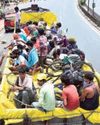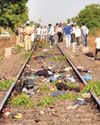A war-like situation heightens the uncertainty in Kashmir.

THREE MONTHS HAVE PASSED SINCE KASHMIR slipped into an unprecedented phase of turmoil following the killing of Hizbul Mujahideen commander Burhan Wani on July 8. Not much has changed. The sufferings of the people have come first in the form of curfew, the longest-ever Kashmir has witnessed since 1990, and now in the form of continued strikes called or protest calendars issued by the joint platform of separatists led by Syed Ali Geelani, Mirwaiz Umar Farooq and Mohammad Yasin Malik. The cost has been heavy: 90 deaths at the hands of the police and paramilitary forces, injuries to 11,000 people and, above all, pellet injuries that have left scores of young boys and girls blind.
So far, the government’s response has only been harsh curfews, and bullets and pellets. The government sees it as a law and order problem that is to be dealt with a “tire-out” strategy as was done during the political un-rests in 2008 and 2010. However, by all accounts, those protests were mild compared with the current phase of unrest, which shows little sign of a let-up.
Kashmir today faces what can be termed a humanitarian crisis. With businesses shut, educational institutions closed and hospitals full of injured, the Valley is as good as dead. There is hardly any dialogue within and outside, as the governments—both in New Delhi and in Srinagar—and the separatists have locked horns with each other. In the meanwhile, there seemed to be some engagement when an all-party delegation visited Srinagar and Jammu on September 4 and 5. It left the door ajar for hope. But that also fizzled out.
Denne historien er fra October 28, 2016-utgaven av FRONTLINE.
Start din 7-dagers gratis prøveperiode på Magzter GOLD for å få tilgang til tusenvis av utvalgte premiumhistorier og 9000+ magasiner og aviser.
Allerede abonnent ? Logg på
Denne historien er fra October 28, 2016-utgaven av FRONTLINE.
Start din 7-dagers gratis prøveperiode på Magzter GOLD for å få tilgang til tusenvis av utvalgte premiumhistorier og 9000+ magasiner og aviser.
Allerede abonnent? Logg på

How Not To Handle An Epidemic
The lockdowns were meant to buy time to put in place appropriate health measures and contain the coronavirus’ spread, but they have failed to achieve the objective and heaped immense misery on the marginalised sections of society. India is still in the exponential phase of the COVID-19 infection and community transmission is a reality that the government refuses to accept.

Tragedy on foot
As the COVID-19-induced lockdown cuts the ground beneath their feet in Tamil Nadu, thousands of migrant workers are trudging along the highway to the relative safety of their upcountry homes.

Sarpanchs as game changers
Odisha manages to keep COVID-19 well under control because of the strong participation of panchayati raj institutions and the community at the grass-roots level under the leadership of Chief Minister Naveen Patnaik.

Scapegoating China
As the COVID-19 death rate spikes and the economy tanks in the United States, Donald Trump and his advisers target China and the World Health Organisation with an eye to winning the forthcoming presidential election.

New worries
Kerala’s measured approach to the pandemic and lockdown has yielded results. But it still has to grapple with their huge economic impact on its economy, which it feels the Centre’s special financial relief package does little to alleviate.
No love lost for labour
Taking advantage of the lockdown and the inability of workers to organise protests, many State governments introduce sweeping changes to labour laws to the detriment of workers on the pretext of reviving production and boosting the economy.

Capital's Malthusian moment
In a world that needs substantial reorienting of production and distribution, Indian capital is resorting to a militant form of moribund neoliberalism to overcome its current crisis. In this pursuit of profit, it is ready and willing to throw into mortal peril millions whom it adjudicates as not worth their means—an admixture of social Darwinism born of capital’s avarice and brutalism spawned by Hindutva. .

Understanding migration
When governments and their plans are found to be blatantly wanting in addressing reverse migration, exercises such as the Ekta Parishad’s survey of migrant workers throughout India can be useful to work out creative long-lasting solutions.

Waiting for Jabalpur moment
The Supreme Court’s role in ensuring executive accountability during the ongoing lockdown leaves much to be desired. Standing in shining contrast is the record of some High Courts.

An empty package
The Modi regime, which has been unable to control the COVID-19 infection, restore economic activity and provide relief to millions exposed to starvation, trains its sights on Indian democracy, making use of the panic generated by fear and a lockdown that forecloses paths of resistance.